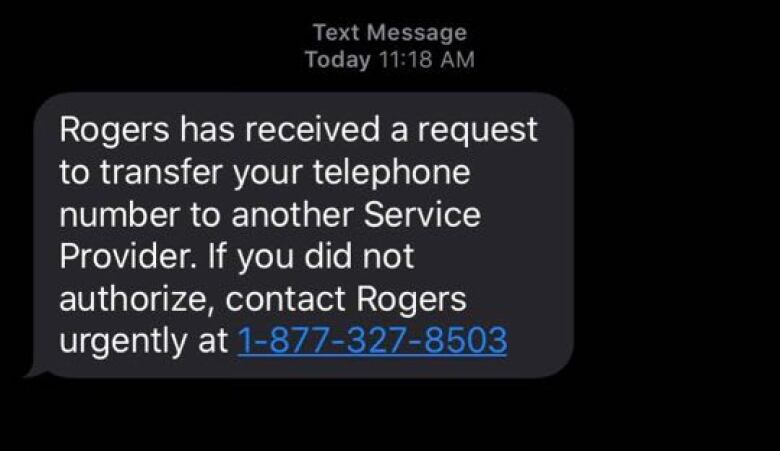P.E.I. woman nearly loses $2K from cellphone fraud
'Dont be like me and think that you live on Prince Edward Island and think that it cant happen'

Katherine Cairns left her cellphone inside her home in Emyvale, P.E.I., to take advantage of some sunshine Sunday morning.
While she was gardening outside, she missed a text message warning thatinformation on her cellphone would be transferred from Rogers to another service provider and she needed to call in the next 30 minutes to stop the process.
But Cairns didn't see that message until she came inside 45 minutes later. As soon as she saw the message from her service provider she said she assumed it was a scam.
"I thought it was a scam and then I turned my phone over a couple minutes later and looked and realized I had no service," Cairns said.
The phenomenon is known as number porting or SIM swap fraud.
It occurs when a fraudster impersonates their target and contacts a service provider to open a new account.
'All within 40 minutes'
The fraudster asks for the target's mobile number to be transferred, or ported, over to the new account being opened by the fraudster, said officials with the Canadian Wireless Telecommunications Association (CWTA) in an email to CBC.
Cairns said it took the fraudster less than an hour to port her number and access several accounts.

"All within 40 minutes of them getting in, they got into my Amazon account and they changed even the fingerprint authenticator on there from my fingerprint to their fingerprint," she said.
Several items were charged to her Amazon account and she had to shut down both her buyer and seller accountsbecause the only way she could reset her password was through her phone, she said.
"They got into my Gmail and they got into my PayPal account and charged about $2,000 worth of stuff on there," Cairns said.
She said she is unsure what was bought but it was four transactions valued at $500 each. Cairns said she has tried to reach PayPal customer servicebut has been unable to, so she deleted all of her cards from the account.
She said she had to open a fraud investigation at her bank and luckily the purchases made on the cards connected to her PayPalaccount were cancelled.
Industry requirement
The Canadian Radio-television and Telecommunications Commission (CRTC) requires service providers to provide wireless number portability. That rule has been in place since 2007, said CWTA in an email.
"Porting numbers is a CRTC requirement that allows wireless subscribers to keep their phone number when they switch service providers. This makes it easier for consumers to switch service providers and offers them greater choice."
In the case of a wireless-to-wireless number porting, the CRTC requires that the port be completed within 2.5 business hours, the email said.
"Unfortunately, there are criminals who are using illegally obtained personal data to defraud consumers in a variety of ways and across industries. Unauthorized phone number transfers are one example."

The CWTA said some service providers have made modifications to their own processes, and the industry is in the midst of making changes to the number porting system that will add new levels of verification.
Cairns said she has seen similar stories where people have had their phones ported and information stolen.
"I was that person who thought 'It probably won't happen to me,'" she said. "No, it happened to me."
Under normal circumstances, Cairns could go to the Rogers store in Charlottetown and get a new SIM card for her phone, but because of the global pandemic Cairns said her cellphone company shut down that storefront.
Cairns received a new SIM card for her cellphone on Wednesday and said while it is great she has her money back, it still doesn't feel good to have someone accessing her personal accounts.
"It feels horrible. It feels like someone robbed you and looked through all your stuff in the middle of the day," she said.
Could you imagine if you had your phone on do not disturbwhen you were sleeping and someone did it overnight? Katherine Cairns
RCMP Sgt. Craig Eveleigh said if people receive a questionable text or email they should take a moment to analyze it.
He said he has talked to victims of similar fraud cases and it can be hard on victims, not only financially but mentally.
"They feel humiliated afterwards telling themselves 'Geezhow could I fall prey to this,' and they put themselves down," he said. "There is a scam out there for everybody."
Eveleigh said officers try to get into Island schools and seniors' homes to educate students and seniors on the types of online or cellphone fraud they should look out for.
He also said people should be careful answering online questionnaires that may be the same as typical questions used to reset passwords, like what colour your first car was.
In an email statement, officials with Rogers said it takes protecting customers' personal information seriously as fraudsters evolve their tactics.
"We work with other carriers to continually strengthen processes to prevent unauthorized porting, including new protections put in place this past fall," the email said.

Cairns said there are a few things people can do to protect their information. She said Rogers offers something called port protection.
"Port protection makes it so that they have to contact you and you have to OK it before someone takes your number," she said.
Cairns said the half-hour she was given to stop her phone from being ported was not long enough.
"There's times when all of us are without our phone. Could you imagine if you had your phone on do not disturbwhen you were sleeping and someone did it overnight," she said. "You should have to OK it before your phone number is transferred."
Cairns said she knows adding extra security steps might be inconvenient, "but it is nothing compared to the inconvenience of having all your information being stolen."
"Don't be like me and think that you live on Prince Edward Island and think that it can't happen to you because it certainly can," she said.
"And all of your stuff can disappear so quickly and it is such a challenge to fix it."
COVID-19: What you need to know
What are the symptoms of COVID-19?
Common symptoms include:
- Fever.
- Cough.
- Tiredness.
But more serious symptoms can develop, including difficulty breathing and pneumonia, which can lead to death.
Health Canada has built aself-assessment tool.
What should I do if I feel sick?
Isolate yourself and call 811. Do not visit an emergency room or urgent care centre to get tested. A health professional at 811 will give you advice and instructions.
How can I protect myself?
- Wash your hands frequently and thoroughly.
- Avoid touching your eyes, nose and mouth.
- Clean regularly touched surfaces regularly.
- Practisephysical distancing.
More detailed information on the outbreak is available on thefederal government's website.












_(720p).jpg)


 OFFICIAL HD MUSIC VIDEO.jpg)
.jpg)



























































































